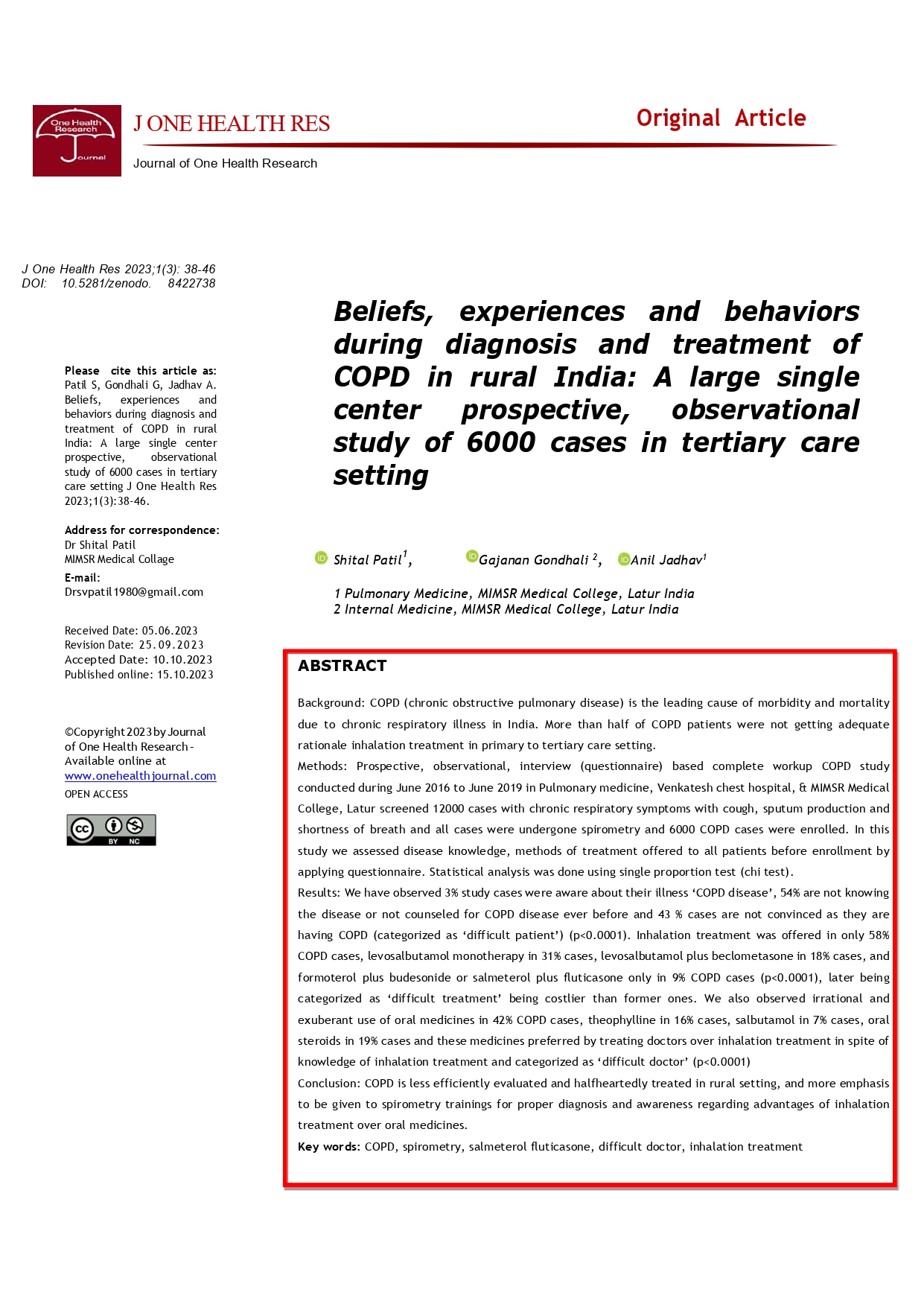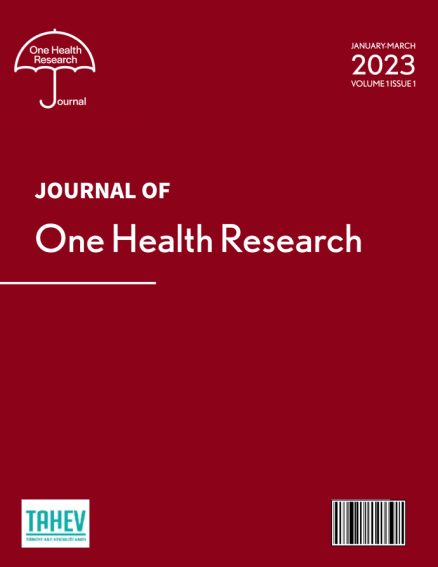Original Paper Beliefs, experiences and behaviors during diagnosis and treatment of COPD in rural India: A large single center prospective, observational study of 6000 cases in tertiary care setting
Beliefs, experiences and behaviors during diagnosis and treatment of COPD
DOI:
https://doi.org/10.5281/zenodo.8422738Abstract
Background: COPD (chronic obstructive pulmonary disease) is the leading cause of morbidity and mortality due to chronic respiratory illness in India. More than half of COPD patients were not getting adequate rationale inhalation treatment in primary to tertiary care setting.
Methods Prospective, observational, interview (questionnaire) based complete workup COPD study conducted during June 2016 to June 2019 in Pulmonary medicine, Venkatesh chest hospital, & MIMSR Medical College, Latur screened 12000 cases with chronic respiratory symptoms with cough, sputum production and shortness of breath and all cases were undergone spirometry and 6000 COPD cases were enrolled. In this study we assessed disease knowledge, methods of treatment offered to all patients before enrollment by applying questionnaire. Statistical analysis was done using single proportion test (chi test).
Observation and analysis: We have observed 3% study cases were aware about their illness ‘COPD disease’, 54% are not knowing the disease or not counseled for COPD disease ever before and 43 % cases are not convinced as they are having COPD (categorized as ‘difficult patient’) (p<0.0001). Inhalation treatment was offered in only 58% COPD cases, levosalbutamol monotherapy in 31% cases, levosalbutamol plus beclometasone in 18% cases, and formoterol plus budesonide or salmeterol plus fluticasone only in 9% COPD cases (p<0.0001), later being categorized as ‘difficult treatment’ being costlier than former ones. We also observed irrational and exuberant use of oral medicines in 42% COPD cases, theophylline in 16% cases, salbutamol in 7% cases, oral steroids in 19% cases and these medicines preferred by treating doctors over inhalation treatment in spite of knowledge of inhalation treatment and categorized as ‘difficult doctor’ (p<0.0001)
Conclusion: COPD is less efficiently evaluated and halfheartedly treated in rural setting, and more emphasis to be given to spirometry trainings for proper diagnosis and awareness regarding advantages of inhalation treatment over oral medicines.
References
References:
GBD, 2015 Chronic Respiratory Disease Collaborators. Global, regional, and national deaths, prevalence, disability-adjusted life years, and years lived with disability for chronic obstructive pulmonary disease and asthma, 1990-2015: a systematic analysis for the Global Burden of Disease Study 2015. Lancet Respir. Med. 5, 691–706 (2017). Erratum in: Lancet Respir. Med. 5, e30 (2017).
GOLD-2021-Pocket-Guide.Global Initiative for Chronic Obstructive Lung Disease, Inc. www.goldcopd.org [accessed on 14 January 2022]
Jindal SK. Emergence of chronic obstructive pulmonary disease as an epidemic in India. Indian J Med Res. 2006 Dec;124(6):619-30.
Jindal SK. Bronchial asthma: the Indian scene. Curr Opin Pulm Med. 2007 Jan;13(1):8-12.
McKay AJ, Mahesh PA, Fordham JZ, Majeed A. Prevalence of COPD in India: a systematic review. Prim Care Respir J. 2012 Sep;21(3):313-21.
India State-Level Disease Burden Initiative Collaborators Nations within a nation: variations in epidemiological transition across the states of India, 1990–2016 in the Global Burden of Disease Study. Lancet. 2017; 390: 2437-2460
Ministry of Health and Family Welfare Government of India National health policy 2017.
Ministry of Health and Family Welfare, New Delhi 2017 https://mohfw.gov.in/documents/policy [accessed on 20 January 2019]
Pierce, R. Spirometry: an essential clinical measurement. Aust. Fam. Physician. 34, 535–539 (2005).
Yawn, B. P. et al. Spirometry can be done in family physicians’ offices and alters clinical decisions in management of asthma and COPD. Chest 132, 1162–1168 (2007).
O’Donnell, D. E. et al. Canadian Thoracic Society recommendations for management of chronic obstructive pulmonary disease--2003. Can. Respir. J. 10(Suppl A): 11A–65A (2003).
Assessing national capacity for the prevention and control of noncommunicable diseases: report of the 2019 global survey. Geneva: World Health Organization; 2020. [accessed on 20 April 2020]
Miller MR, Hankinson J, Brusasco V, Burgos F, Casaburi R, Coates A, et al. Standardization of spirometry. Eur Respir J. 2005; 26:153-61.
Ghorpade, D.D., Raghupathy, A., Londhe, J.D. et al. COPD awareness in the urban slums and rural areas around Pune city in India. npj Prim. Care Respir. Med. 31, 6 (2021). https://doi.org/10.1038/s41533-021-00220-4
Yıldız, F. et al. The evaluation of asthma and COPD awareness in Turkey (GARD Turkey Project-National Control Program of Chronic Airway Diseases). Tuberk. Toraks 61, 175–182 (2013)
Asai, M. et al. Effect of a chronic obstructive pulmonary disease (COPD) intervention on COPD awareness in a regional city in Japan. Intern Med. 54, 163–169 (2015).
Soriano, J. B. et al. The general public’s knowledge of chronic obstructive pulmonary disease and its determinants: current situation and recent changes. Arch. Bronconeumol. 48, 308–315 (2012)
Roche, N. et al. The gap between the high impact and low awareness of COPD in the population. Rev. Maladies Respir. 26, 521–529 (2009).
Bayram, M. & Akgün, M. If you know the enemy and your weapons, you need not fear the management of chronic obstructive pulmonary disease. Turk. Thorac. J. 18, 100 (2017).
Grouse, L. & Nonikov, D. The global battle to improve patients’ health outcomes: COPD awareness, activities, and progress. J. Thorac. Dis. 6, 161–168 (2014).
J. Zielinski, M. Bednarek, D. Górecka, G. Viegi, S. S. Hurd, Y. Fukuchi, C. K. W. Lai et al. Increasing COPD awareness. European Respiratory Journal 2006 27: 833-852.
Buffels J, Degryse J, Heyrman J, Decramer M. Office spirometry significantly improves early detection of COPD in general practice: the DIDASCO Study. Chest 2004;125:1394–1399.
Eaton T, Withy S, Garrett JE, Mercer J, Whitlock RM, Rea HH. Spirometry in primary care practice: the importance of quality assurance and the impact of spirometry workshops. Chest 1999;116:416–423.
Schermer TR, Jacobs JE, Chavannes NH, et al. Validity of spirometric testing in a general practice population of patients with chronic obstructive pulmonary disease (COPD). Thorax 2003;58:861–866.
Enright PL, Beck KC, Sherrill DL. Repeatability of spirometry in 18,000 adult patients. Am J Respir Crit Care Med 2004;169:235–238.
Mannino D M, Homa D M, Akinbami L J, Ford E S, Redd S C. Chronic obstructive pulmonary disease surveillance–United States, 1971–2000. MMWR Surveill Summ 2002; 51(6)1–16
Tinkelman D G, Price D B, Nordyke R J, Halbert R J. Misdiagnosis of COPD and asthma in primary care patients 40 years of age and over. J Asthma 2006; 43(1)75–80
Lee T A, Bartle B, Weiss K B. Spirometry use in clinical practice following diagnosis of COPD. Chest 2006; 129(6)1509–1515
Dales R E, Vandemheen K L, Clinch J, Aaron S D. Spirometry in the primary care setting: influence on clinical diagnosis and management of airflow obstruction. Chest 2005; 128(4)2443–2447
Barry Make, Gerard Criner & Fernando Martinez (2007) Raising Awareness of COPD: A Call to Action by the Readers of COPD, COPD: Journal of Chronic Obstructive Pulmonary Disease, 4:1, 1-2, DOI: 10.1080/15412550601169570
Borghardt J, Kloft C, Sharma A. Inhaled therapy in respiratory disease: the complex interplay of pulmonary kinetic processes. Can Respir J. 2018;2018:2732017. doi:10.1155/2018/2732017
Restrepo RD, Alvarez MT, Wittnebel LD, et al. Medication adherence issues in patients treated for COPD. Int J Chron Obstruct Pulmon Dis. 2008;3(3):371-384. doi:10.2147/copd.s3036
Foster JA, Yawn BP, Maziar A, Jenkins T, Rennard SI, Casebeer L. Enhancing COPD management in primary care settings. MedGenMed. 2007;9(3):24. Published 2007 Jul 31.
Hanlon JT, Schmader KE, Ruby CM, et al. Suboptimal prescribing in elderly inpatients and outpatients. J Am Geriatr Soc. 2001;49:200–9.
Stuart B. Navigating the new Medicare drug benefit. Am J Geriatr Pharmacother. 2004;2:75–80
Maio V, Pizzi L, Roumm Ar, et al. Pharmacy utilization and the Medicare Modernization Act. Milbank Q. 2005;83:101–30.
Rutten-van Mölken MP, Oostenbrink JB, Miravitlles M, et al. Modelling the 5-year cost effectiveness of tiotropium, salmeterol and ipratropium for the treatment of chronic obstructive pulmonary disease in Spain. Eur J Health Econ. 2007;8:123–35
Oba Y. Cost-effectiveness of long-acting bronchodilators for chronic obstructive pulmonary disease. Mayo Clin Proc. 2007;82:575–82.
Lee KH, Phua J, Lim TK. Evaluating the pharmacoeconomic effect of adding tiotropium bromide to the management of chronic obstructive pulmonary disease patients in Singapore. Respir Med. 2006;100:2190–6
Dal NR, Eandi M, Pradelli L, et al. Cost-effectiveness and healthcare budget impact in Italy of inhaled corticosteroids and bronchodilators for severe and very severe COPD patients. Int J Chron Obstruct Pulmon Dis. 2007;2:169–76.
Gupta, Dheeraj et al. “Guidelines for diagnosis and management of chronic obstructive pulmonary disease: Joint ICS/NCCP (I) recommendations.” Lung India : official organ of Indian Chest Society vol. 30,3 (2013): 228-67. doi:10.4103/0970-2113.116248
Ma YJ, Jiang DQ, Meng JX, et al. Theophylline: a review of population pharmacokinetic analyses. J Clin Pharm Ther 2016; 41: 594–601
Adil MS, Khan MA, Khan MN, et al. EMPADE Study: Evaluation of Medical Prescriptions and Adverse Drug Events in COPD Patients Admitted to Intensive Care Unit. J Clin Diagn Res. 2015;9(11):FC05-FC8. doi:10.7860/JCDR/2015/14563.6721
Miravitlles M, Mayordomo C, Artés M, Sánchez-Agudo L, Nicolau F, Segú JL. Treatment of chronic obstructive pulmonary disease and its exacerbations in general practice. EOLO Group. Estudio Observacional de la Limitación Obstructiva al Flujoa Ereo. Respir Med. 1999;93(3):173–79.
Cazzola M, Calzetta L, Barnes PJ, et al. Efficacy and safety profile of xanthines in COPD:
a network meta-analysis. Eur Respir Rev 2018; 27: 180010 https://doi.org/10.1183/16000617.0010-2018.

Downloads
Published
How to Cite
Issue
Section
License
Copyright (c) 2023 Journal of One Health Research

This work is licensed under a Creative Commons Attribution 4.0 International License.



